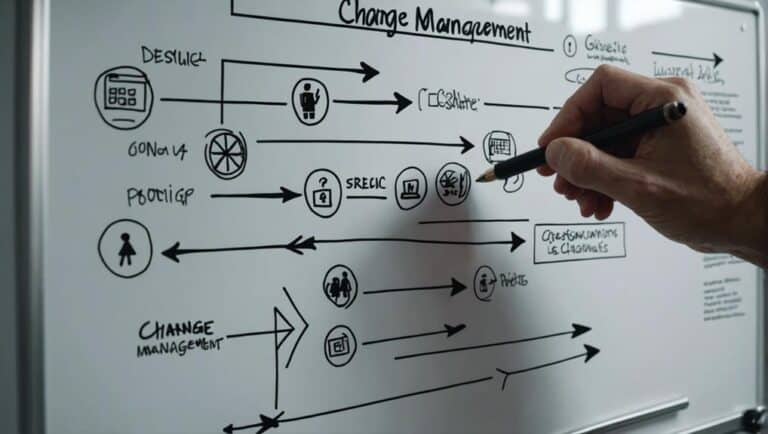In order to overcome change management challenges, it is important to understand the four major components of organizational change, but what are they?
The 4 major components of organizational change are design, communication, engagement, and execution. Each of these components is essential for a successful change management initiative.
When an organization decides to make a change, it’s important that they have a clear understanding of all these areas.
Whatever the reason may be, it’s important that all aspects of the company are on board with the changes before they’re implemented. This includes management, employees, and customers / clients. Otherwise, there will likely be resistance and setbacks along the way.
It’s also important to remember that organizational change is hard! Knowing what not to do is just as important as knowing what to do.
The 4 major components of organizational change
There are four major components of organizational change: design, communication, engagement, and execution.
Design
The designing of a new process or system requires an understanding of how things work now, as well as the end goal.
It also involves ensuring all parties involved in the process have a shared vision of the future.
Mapping out business processes is a key component of this stage. Process maps allow staff at all organization levels to see and understand current internal processes and external processes.
Gaining a deep understanding of these allows the design of changes to be created to complete the executive team business strategy.
Creating a pre-change process map and post-change map can be a very effective part of the communication plan.
Communication
Effective communication is key to any change management initiative. Making sure the right people are kept informed at the right time is hugely helpful and can ensure less resistance to change.
The more people know about the change, the better they can prepare themselves for it. You’re also more likely to discover potential issues if you involve individuals from all organizational levels, no one person will know everything so gathering feedback is vital.
A communication plan should be created, one that makes use of any appropriate channels available. These could be:
- Video
- In person briefing
- Notice boards
- Focus groups
Make sure to include a communication plan as part of the overall project or programme plan. After all, you don’t want to be THAT company that rolls out changes which business leaders forget to tell people about.
Engagement
Engaging your team members is one of the most important parts of any change management initiative. You need to ensure that everyone has buy-in for the change, and that they feel like their voice is being heard.
If appropriate, make use of focus groups to workshop the proposed change ideas, get the people with concerns involved in the process, let them question the ideas, point out the problems, and then come up with a better version.

By including and engaging with your team, not only will they appreciate being part of the change, but you may also find you avoid a lot of problems by allowing others to ‘check your homework’ before anything is implemented.
Execution
Once you’ve designed the change, communicated it effectively, and engaged your team, it’s time to get started executing the plan.
Make sure that you give yourself enough time to execute the change successfully. It would be foolish to think that you can just implement a change overnight and expect it to succeed.
You’ll need to test the change to make sure it works, and that it meets your expectations. If there are issues, address them immediately.
Ensure that you have measurements in place to monitor the impact of change, be it KPIs, staff / customer satisfaction surveys, or daily reporting.
Why is organizational change important?
Organizational change is important because it allows a company to grow and adapt to the ever-changing needs of its customers and the operating environment.
By implementing new policies or guidelines, a company can improve its efficiency and effectiveness, and become more competitive in the marketplace.
While the ideal situation is gradual, controlled change, there are going to be times when change is forced upon us as a necessity. For example, office workplaces suddenly had to adapt to home working during the Covid-19 pandemic that caused places of work to close temporarily.
Having an effective change management process and team in place allows you to react to such problems quickly and efficiently.
Additionally, organizational change can help employees feel more engaged and motivated, leading to a higher level of productivity.
Finally, change is necessary for companies that want to stay ahead of the curve and maintain their leadership position in their industry.
What are the challenges of organizational change?
When an organization embarks on a change initiative, it is typically attempting to address a problem or improve performance. Unfortunately, change is often difficult and challenging, even when it is needed and desired. There are several challenges that can impede the success of a change initiative.
Resistance to change is one of the biggest challenges an organization can face. People are naturally resistant to change, particularly if they fear it will impact their jobs or status within the organization. This resistance can manifest in numerous ways, such as active resistance, passive resistance, or simply not putting forth the effort to make the change succeed. This can lead to a lot of conflict within an organization and slow down the implementation process.
Another challenge is the lack of buy-in from key stakeholders. If the people responsible for implementing or executing the change initiative do not believe in it, or if they don’t see the value in it, it will likely fail. Similarly, if the people who will be most affected by the change don’t understand or support it, it will be difficult to make progress.
A third challenge is the lack of a clear vision or strategy. If the organization doesn’t have a clear idea of what it is trying to achieve with the change, or if there is no clear plan for how to achieve it, the chances of success are slim. Without a solid plan in place, there’s no way to measure success or track progress along the way. This can lead to frustration on everyone’s part and cause the change initiative to fail altogether.
Finally, change can be expensive and time-consuming. If the organization isn’t prepared to invest the time and money necessary to make the change successful, it will likely fail. In some cases, if there isn’t a clear vision or strategy the cost can ultimately be far higher than expected, leading to a sense of failure even if the change has been successfully implemented.
While change can be difficult, it is often necessary for organizations to thrive and grow. By understanding and addressing the challenges that are commonly associated with change, organizations can be more successful in implementing change initiatives and achieving their goals.
How can resistance to change be overcome?
When it comes to implementing change within a business, there will always be some level of resistance. After all, change can be disruptive and can threaten the status quo.
However, if you’re looking to successfully manage change within your company, there are a few things you can do to overcome resistance and ensure a smooth transition.
1. Communicate the need for change
One of the most important things you can do when implementing change is to communicate the need for it. Employees need to understand why changes are being made and how they will impact them. If they feel like they’re being kept in the dark, they’re likely to resist change.
2. Tie changes to the company’s goals
When employees understand why changes are being made, they’re more likely to buy into them. Change should always be tied to the company’s goals and objectives. If employees feel like the changes are being made for the benefit of the company and not just to disrupt their work, they’re more likely to go along with them.
3. Give employees a voice
Employees should be given a voice in the decision-making process when it comes to changes. They should be able to provide feedback and offer their thoughts on how changes can be implemented. This will help to ensure that they feel like they’re part of the process and that their concerns are being heard.
4. Get help from outside experts
If you’re struggling to manage change within your company, it can be helpful to get help from outside experts. There are many consultants who specialize in change management and can help to smooth the transition process.
5. Don’t force change
Finally, remember that it’s important to take a light touch with change. Don’t try to force it on employees who aren’t ready for it. Gradual change is more likely to be successful than sudden change.
To recap: to overcome resistance to change, it is important to have a clear vision and communicate that vision effectively to all stakeholders. It is also important to have a plan for implementing the change and to provide support to those who are affected by the change. Finally, it is essential to be patient and flexible, and to be prepared for setbacks.
What are the benefits of organizational change?
There are many benefits to implementing organizational change. Some of these benefits include increased sustainability and profits, improved communication and collaboration, and increased efficiency.
By implementing change in a structured and controlled manner, an organization can improve its chances of achieving its goals. Additionally, change can help to improve morale and create a more positive work environment.
Change management, the practice of planning, implementing, and monitoring changes to organisational structures, processes, and systems, has become an essential function in many organisations. Despite this, change management is often viewed as a necessary evil, and many organisations approach it in a reactive rather than proactive way.
This can lead to frustration on the part of employees, who may feel that changes are being forced on them without input or consultation.
It can also lead to disaster, as changes that are poorly planned or implemented can disrupt workflows and damage relationships among employees.
However, when change management is done well, it can bring many benefits to an organisation. Some of the most important benefits include:
- Improved communication and collaboration among employees
- Increased efficiency and productivity
- A more positive attitude toward change among employees
- Improved problem-solving ability
- Enhanced creativity and innovation
- Stronger team spirit
- Greater employee engagement
When a company undergoes organizational change, it can often see a significant increase in its sustainability and profits. This is because the company is able to use its resources more efficiently and effectively after the change has been implemented.
In order to achieve these benefits, organisations must approach change management in a meaningful and holistic way.

This means that changes must be planned and executed in a way that takes into account the individual and cultural needs of employees.
It also means that changes must be monitored and adjusted as needed in order to ensure that they are having the desired effect.
Change management can be a difficult process, but it is crucial for the success of any organisation. By taking the time to plan and implement changes in a thoughtful way, organisations can realise a range of benefits that can improve productivity and help them stay competitive in today’s market.
How can organizations prepare for change?
While each business is different, there are some common steps that can be taken in order to prepare for a change implementation. We’ve already covered the 4 key steps. Here are some additional areas that can be done as part of the preparation:
- Create current state process maps
- Collect feedback from staff / customers regarding the status quo
- Ensure reporting is in place
- Prepare a project team
If there are many projects taking place be such to implement programme management. If all of this sounds beyond the capability you currently have in house, consider sourcing a change management consultant.
Then the first step is to assess the organization’s readiness for change. This includes understanding the current environment and identifying the gaps between where the organization is currently and where it wants to be.
Once the assessment is complete, the next step is to create a plan detailing how to close those gaps. The plan needs to be tailored specifically to the organization’s needs and should include specific timelines and resources required.
Once the plan is in place, it’s time to execute it! This step requires coordination across all parts of the organization and constant communication with stakeholders.
Finally, once changes have been made it’s important to monitor and evaluate their impact on business goals. This helps determine if further changes are necessary or if adjustments need to be made in order for things to continue running smoothly.
What are the lessons learned from successful and unsuccessful organizational change initiatives?
There are many lessons that can be learned from both successful and unsuccessful organizational change initiatives.
One of the most important things to keep in mind is that change management can be difficult to implement if governance tools are not available or in place.
In addition, data access is important for effective change management, which often involves moving processes from one user to another without delay or confusion.
It’s also important to remember that successful organizations stick to their goals and don’t let unrealistic deadlines get them down.





